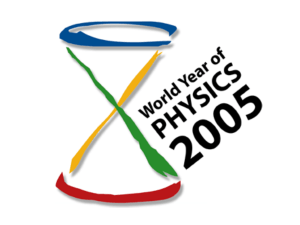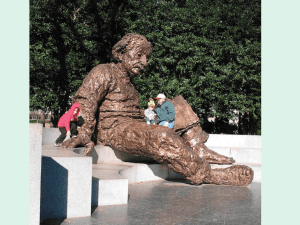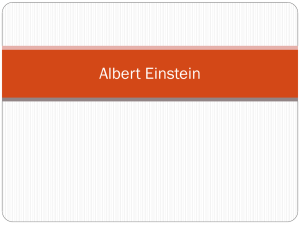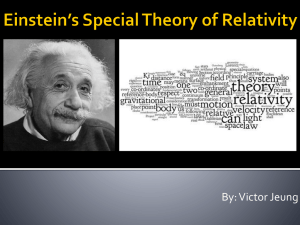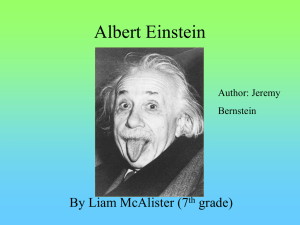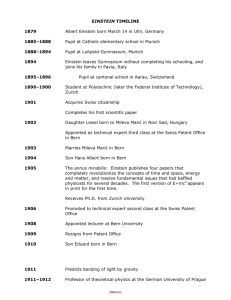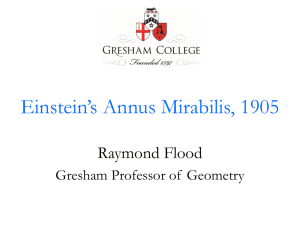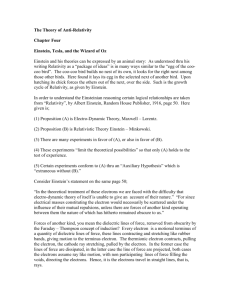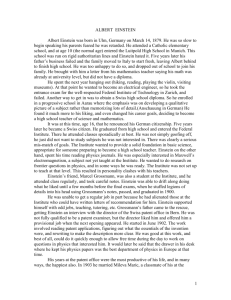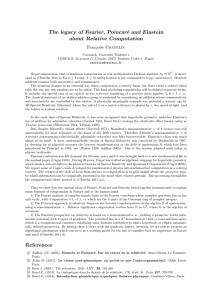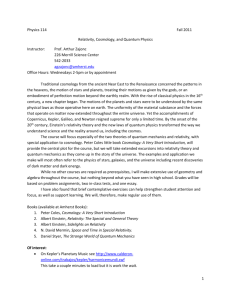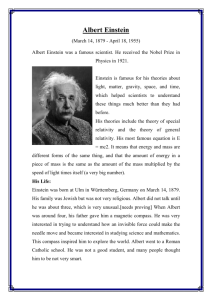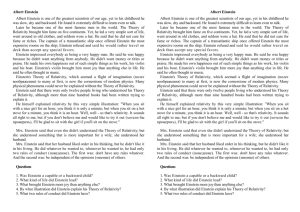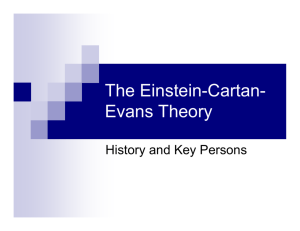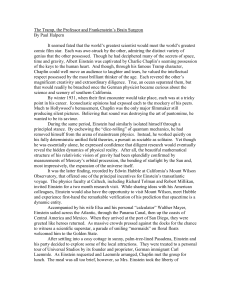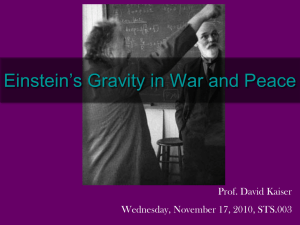De Oreo: The Essentials of Special Relativity
advertisement
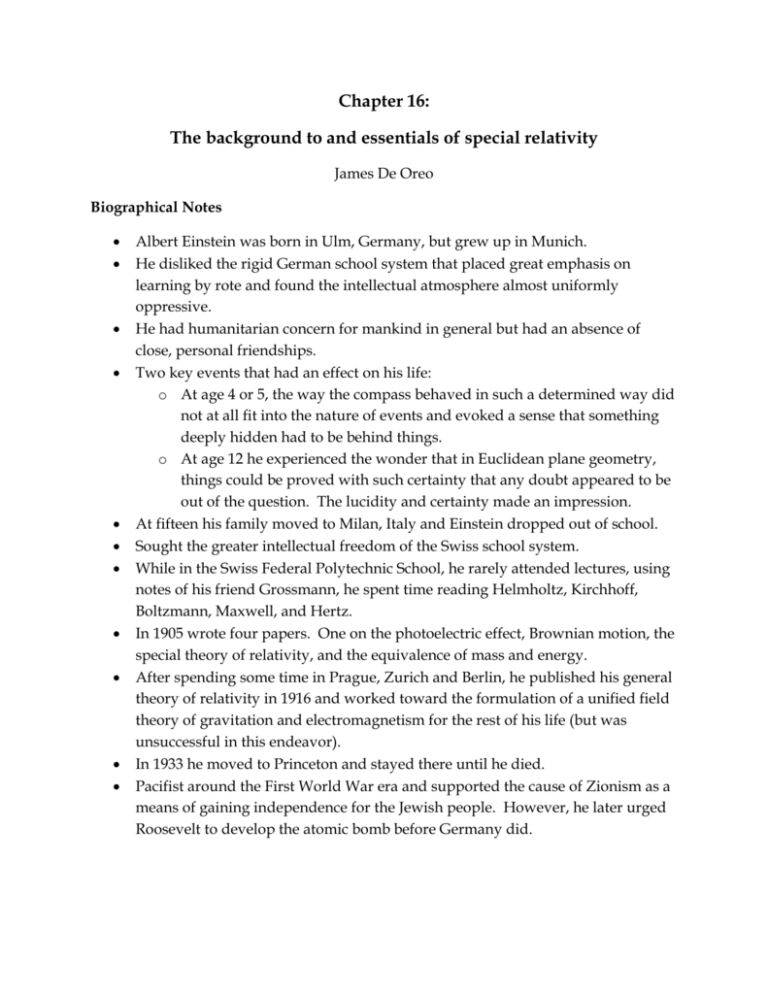
Chapter 16: The background to and essentials of special relativity James De Oreo Biographical Notes Albert Einstein was born in Ulm, Germany, but grew up in Munich. He disliked the rigid German school system that placed great emphasis on learning by rote and found the intellectual atmosphere almost uniformly oppressive. He had humanitarian concern for mankind in general but had an absence of close, personal friendships. Two key events that had an effect on his life: o At age 4 or 5, the way the compass behaved in such a determined way did not at all fit into the nature of events and evoked a sense that something deeply hidden had to be behind things. o At age 12 he experienced the wonder that in Euclidean plane geometry, things could be proved with such certainty that any doubt appeared to be out of the question. The lucidity and certainty made an impression. At fifteen his family moved to Milan, Italy and Einstein dropped out of school. Sought the greater intellectual freedom of the Swiss school system. While in the Swiss Federal Polytechnic School, he rarely attended lectures, using notes of his friend Grossmann, he spent time reading Helmholtz, Kirchhoff, Boltzmann, Maxwell, and Hertz. In 1905 wrote four papers. One on the photoelectric effect, Brownian motion, the special theory of relativity, and the equivalence of mass and energy. After spending some time in Prague, Zurich and Berlin, he published his general theory of relativity in 1916 and worked toward the formulation of a unified field theory of gravitation and electromagnetism for the rest of his life (but was unsuccessful in this endeavor). In 1933 he moved to Princeton and stayed there until he died. Pacifist around the First World War era and supported the cause of Zionism as a means of gaining independence for the Jewish people. However, he later urged Roosevelt to develop the atomic bomb before Germany did. Einstein's Philosophy The philosophers that had the greatest influence on him were Hume, Mach, and Poincare. Einstein admired Mach's incorruptible skepticism and independence and credited Hume and Mach with developing the critical attitude necessary to revise his concepts of space and time. Other important influences were Maxwell's theory of unified optics and electromagnetism and Lorentz' ideas about fields existing in empty space whereby space and not matter bore the electromagnetic field. Einstein is usually considered to be a logical positivist. He did not accept metaphysical presuppositions as conclusive, but based the elements of his theory upon observed facts. However, he also believed that general theories could not be arrived at by a direct examination of the empirical facts alone, but that a free invention of the human mind was also required, after which the theory must be tested to see whether or not it agreed with the phenomena of nature. Metaphysics was rejected due to lack of abstract reasoning concerning quantity or number and any experimental reasoning concerning matter of fact and existence. Rather, the focus was on the only 'meaningful' statements which are those that either were analytically (true by definition and based on logical implications of words and ideas) or empirically verifiable.1 Two issues that concerned Einstein and led to the formulation of special relativity was electric currents and light. First, with a magnet and a conductor, the observable phenomena only depend on the relative motion of the magnet and conductor. Whether just the magnet or just the conductor moves, electric currents of the same path and intensity are produced. Second, light is always propagated in empty space with a definite velocity c which is independent of the state of motion of the emitting body. Einstein's theory does not need 'luminiferous ether', 'absolutely stationary space', or assigning a velocity-vector to a point of the empty space in which electromagnetic processes take place. The postulates 1. The form of the laws of physics is the same in all inertial frames (This implies that the laws of physics cannot be used to measure an absolute velocity). 2. The speed of light has the same constant value for all inertial observers. 1 Stumpf. Socrates to Sartre and Beyond. Theories of principle vs. constructive theories Theories of principle employ the analytic. They are logical perfection and security of the foundations. Epistemic security of the deduced consequences once the basic principles were accepted and have generality of applicability. Some examples are thermodynamics or special relativity. Constructive theories are synthetic and have benefit of completeness, adaptability, and clearness. They are an attempt to build up a picture of the more complex phenomena out of the materials of a relatively simple formal scheme from which they start out. When we say we have succeeded in understanding a group of natural processes, we mean that a constructive theory has been found which covers the processes in question. Most types of theories are constructive. Some examples are kinetic theory of gases or Lorentz aether-based theory of the electron. References Cushing, James T. Philosophical Concepts in Physics. Cambridge University Press. 1998. Kennedy, Robert E. A Student's guide to Einstein's Major Papers. Oxford University Press. 2012. Stumpf, Samuel Enoch. Socrates to Sartre and Beyond. 7th edition. McGraw-Hill. 2003.



